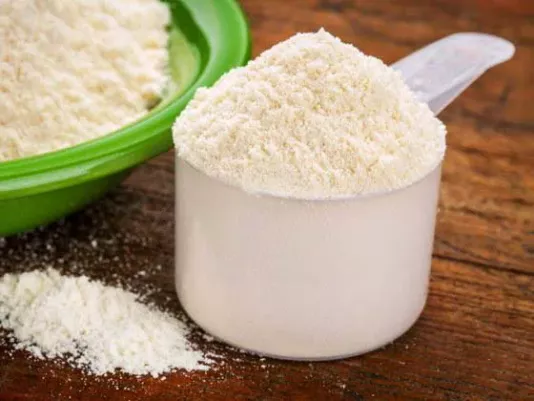Pretzel
Pretzel – a recipe for German cuisine, very popular pretzels are made in Bavaria at festivities such as Oktoberfest.

Powdered milk is a dairy product in powdered form that preserves all the beneficial properties and taste qualities of fresh milk. It is produced by evaporating liquid from whole or skimmed milk, after which a dry powder is obtained, suitable for long-term storage. I use powdered milk for making creams, baked goods, desserts, and hot beverages, as it gives dishes a rich milky taste, making the texture delicate and uniform. The product is convenient and economical – a small portion of powder can replace a significant amount of fresh milk. In world cuisine, powdered milk is used not only in homemade dishes but also in professional baking, confectionery products, and gastronomic experiments, making it a universal ingredient for various recipes. For me, powdered milk means practicality and taste combined in a compact and convenient form. Different types of powdered milk – skimmed, whole, ultra-pasteurized – allow recipes to be easily adapted to specific culinary needs.
Powdered milk comes in different types, and I always choose it depending on the recipe and desired result. Whole powdered milk retains the fat content and rich taste of fresh milk, making it ideal for creams, desserts, and baking. Skimmed powdered milk contains less fat, so it is often used in dietary dishes or for preparing drinks with lower calorie content. There are also special varieties – ultra-pasteurized or stabilized powdered milk, which does not lose its qualities during long storage and heating. I often experiment by combining different types of powdered milk in doughs and creams to achieve optimal texture and aroma. It is important to dissolve the powder properly in liquid, gradually adding water or milk and stirring thoroughly to avoid lumps. In global cuisine, powdered milk is used universally – in European confectionery, in cocoa and drinks in America, in creams and sauces in Asia. For me, knowing the features of different types of powdered milk ensures a stable and high-quality result in any recipe.
Powdered milk is an essential ingredient in baking and confectionery, and I often use it to give dough and creams a more intense flavor. In bread and rolls, it improves the crumb structure, making it softer and fluffier. Baked goods with powdered milk have a pleasant milky aroma and stay fresh longer, which is especially important when cooking for guests or festive tables. In desserts such as creams, mousses, and puddings, powdered milk provides a smooth texture and stability of the finished product, even if different types of fats are used. I often add it to chocolate and vanilla creams to enhance the aroma, as well as to cookie or cake batter to make the taste deeper and richer. In addition, powdered milk helps achieve a uniform consistency without excess liquid, which is particularly valuable in both professional and home cooking. Thanks to its versatility, this ingredient is widely used in cuisines worldwide, from European confectionery to American home recipes, making it an integral part of my kitchen practice.
Powdered milk is indispensable not only in baking but also in preparing beverages and sauces. I often add it to cocoa, hot chocolate, coffee drinks, or smoothies – it makes the liquid richer and softer, giving a pleasant milky aroma and light creamy texture. In sauces, powdered milk helps achieve a uniform consistency, stabilize creamy or cheese sauces, and enhance flavor without adding extra liquid. I use the powder in milk-based soups, casseroles, and pasta sauces to achieve perfect thickness and richness. Powdered milk is especially valuable for preparing beverages and dishes in large quantities – it is easy to measure, stores well, and always ensures consistent flavor. In global cuisine, this product is used in a wide variety of recipes: from European milkshakes to Asian milk-based desserts. For me, powdered milk is a universal ingredient that helps achieve creamy texture and fullness of flavor in any dish.
Powdered milk pairs well with many products, and I always take this into account when cooking. It emphasizes the flavor of chocolate, vanilla, fruits, berries, and nuts, making desserts richer and more balanced. In baking, I often add powdered milk along with flour to make the dough more elastic and tender, while the finished products have a uniform structure and pleasant milky aroma. In hot dishes and sauces, the powder helps achieve a creamy consistency, and in drinks – it makes the taste deeper and more layered. I also experiment with combining powdered milk and spices, such as cinnamon or cardamom, to give dishes a refined flavor accent. In world cuisine, powdered milk is used in European pastries, American hot drinks, and Asian desserts, which makes it a universal ingredient for any kitchen. For me, it is important to combine powdered milk correctly with other ingredients to preserve its delicacy and natural taste, as well as to create a harmonious dish that will delight guests and family.
My experience shows that the proper use of powdered milk ensures stable taste and texture of dishes. Before adding it to dough or cream, it should be carefully dissolved in liquid – water or milk – gradually, to avoid lumps. For a richer taste, I sometimes use a mix of powdered milk and a small amount of fresh milk, especially in desserts and baking. Powdered milk should be stored in airtight packaging in a cool, dry place, away from direct sunlight, to preserve its aroma and properties. Open packaging is best used within a few weeks, while the remainder should be tightly sealed or transferred into a container with a secure lid. I also use powdered milk for preparing hot drinks, sauces, puddings, and casseroles – it stabilizes consistency and enhances the flavor of other ingredients. For me, powdered milk is a universal ingredient that provides practicality, long shelf life, and the ability to create dishes with a rich milky flavor in any recipe.